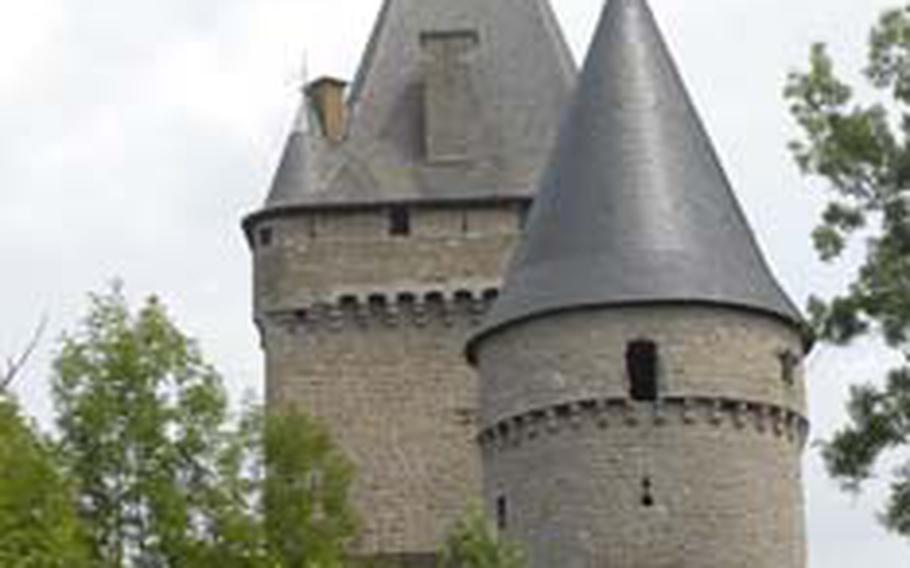
The chateau in Hollenfels, Luxembourg, is closed to the public, but there is a hostel nearby as well as hiking and other outdoor activities. (Mark Abramson / S&S)
Winding tree-lined country roads, old chateaus, green valleys, a beautiful garden and hiking trails that cut through thick forest brush are just a sample of the sights in Luxembourg’s "Valley of the Seven Castles."
OK, so the "castles" in the valley are actually chateaux. But they are still impressive. Unfortunately, of the two I saw, visitors can only get a glance at the chateau at Hollenfels from the outside — it is state-owned — and get inside the privately owned one at Ansembourg if they are members of a foundation that allows access.
But the views from the Hollenfels chateau of the green valley formed by the Eisch River and the trails in the area that wind through it make the trip worth the effort. The 14th-century chateau sits majestically on a hill in the town’s center, and though it is not open to the public, for those who want to get a better feel for the grounds, there is a hostel built in an outer courtyard.
The terraced garden at the Grand-Chateau of Ansembourg is splendid. Entry is free and it is a treat to take in, whether you just want to grab a nap under a tree, park yourself on a bench amid the manicured shrubs or take a gander at a row of classical statuettes along a path called the "mythological walk." The statues were restored in 2000.
The gardens, bounded by a centuries-old stone wall and an arched entryway, feature reflecting pools around a fountain and another fountain built into a stairway. The soothing sound of flowing water adds to the ambiance.
Ansembourg’s Grand-Chateau gardens is just a stroll down the chateau’s courtyard, which, according to information provided by the chateau, was built between 1639 and 1647 and enlarged by the descendants of its builder, Thomas Bidart. The gardens were laid out by Count Lambert-Joseph. The chateau is now undergoing extensive renovation, but the garden has remained open to the public during the work.
The other five "castles" on the 25-mile drive between the towns of Koerich and Mersch are the ruins of Grevenburg Castle in Koerich, the Old Chateau Ansembourg and the Septfontaines, Schoenfels and Mersch castles, none of which is open to the public.
The drive to the valley is scenic in itself. It goes past small farms with cows grazing on the side of the road, donkeys roaming in pens and other animals to behold. Oftentimes it meanders through the forest, making it necessary to use headlights during the day because of the thick tree canopies shading the road from the sun.
The residents of the area speak French, but will try to speak English with visitors seeking information.
While there are a few restaurants in the area, more variety can be found in the city of Luxembourg, which is about 12 miles from the valley.
Directions:To reach the Grand-Chateau of Ansembourg from southwestern Germany, take Autobahn 6 toward Saarbrücken to Exit 8 and then head toward Luxembourg/Trier/A1/Saarlouis on A8, which becomes A13 at the Luxembourg border. Stay on E25 — it changes from A13 to A4 to A6 — to Exit 3 and head toward Kopstal, where you will pick up N12. Follow it north across the Eisch River to CR105 and turn right. The road follows the river to Ansembourg. To reach Hollenfels, which is visible from Ansembourg, either follow that road to the intersection with CR113, turn left and stay on it as it winds past Hollenfels, or take Rue d’Ansembourg northeast to its intersection with Rue de Chateau.
Times: The garden at Ansembourg is open 10 a.m. to 1 p.m. and 3-7 p.m. The hiking trails are always open.
Costs: There is no charge for admission to the gardens or use of the hiking trails.
Food: Restaurants are few and far between, but there are some, including eateries selling Italian food, with prices in the 8-to-10-euro range. There are pricier French restaurants with entrees costing 21 euros or more.
Information: The Luxembourg tourist Web site, www.ont.lu, has a section on culture that includes a list of castles and castle ruins, including the "Valley of the Seven Castles." Find additional information by putting the name of the chateau into a search engine. For questions about the Grand-Chateau of Ansembourg and its gardens, call (+352) 30-88-41-402.